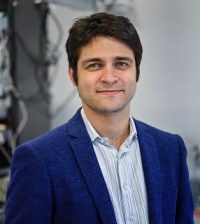Communicating with Cells and Microchips Inside the Body Using Sound Waves and Magnetic Fields

Speaker: Prof. Mikhail G. Shapiro
Affiliation: California Institute of Technology
Abstract: The study of biological function in intact organisms and the development of targeted cellular therapeutics necessitate methods to image and control cellular function in vivo. Technologies such as fluorescent proteins and optogenetics serve this purpose in small, translucent specimens, but are limited by the poor penetration of light into deeper tissues. In contrast, most non-invasive techniques such as ultrasound and magnetic resonance imaging – while based on energy forms that penetrate tissue effectively – are not effectively coupled to cellular function. Our work attempts to bridge this gap by engineering biomolecules with the appropriate physical properties to interact with magnetic fields and sound waves, and external devices and signal processing methods to interact with these biomolecules. In this talk, I will describe our recent development of biomolecular reporters for ultrasound. The reporters are based on a unique class of gas-filled protein nanostructures from buoyant photosynthetic microbes. These proteins produce nonlinear scattering of sound waves, enabling their detection with ultrasound. I will describe our recent progress in understanding the biophysical and acoustic properties of these biomolecules, engineering their mechanics and targeting at the genetic level, developing methods to enhance their detection in vivo1-3. In addition, I will describe our work on microscale electronic devices whose precise location inside the body can be determined with magnetic field gradient encoding. Analogous to nuclear spins in MRI, these devices are designed to communicate at different RF frequencies depending on their local magnetic field. This allows their location to be determined non-invasively with sub-millimeter precision4.
- Shapiro, M.G. et al. Biogenic gas nanostructures as ultrasonic molecular reporters. Nat. Nanotechnol. 9, 311-316 (2014).
- Bourdeau, R.W. et al. Acoustic reporter genes for non-invasive imaging of microorganisms in mammalian hosts. Nature 553, 86-90 (2018).
- Lu, J. et al. Acoustically modulated magnetic resonance imaging of gas-filled protein nanostructures Nat. Mater. (2018).
- Monge, M., Lee-Gosselin, A., Shapiro, M.G. & Emami, A. Localization of microscale devices in vivo using addressable transmitters operated as magnetic spins. Nature Biomedical Engineering 1, 736 (2017).
Biography: Mikhail G. Shapiro is an Assistant Professor of Chemical Engineering and a Heritage Principal Investigator at Caltech. He received his PhD in Biological Engineering from MIT and his BSc in Neuroscience from Brown. He conducted post-doctoral research in biophysics at the University of Chicago and was a Miller Fellow at the University of California, Berkeley. He has received the Burroughs Wellcome Career Award at the Scientific Interface, the DARPA Young Faculty Award, the Pew Scholarship, the Sontag Foundation Distinguished Scientist Award, the Packard Fellowship and the Technology Review TR35 award for top innovators under age 35. More information about the Shapiro Lab can be found online at shapirolab.caltech.edu.
For more information, contact Prof. Yuanxun “Ethan” Wang (ywang@ee.ucla.edu)
Date/Time:
Date(s) - Jun 04, 2018
12:30 pm - 1:30 pm
Location:
EE-IV Shannon Room #54-134
420 Westwood Plaza - 5th Flr., Los Angeles CA 90095
